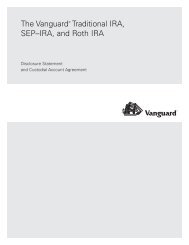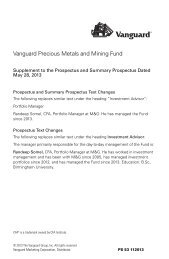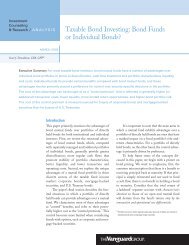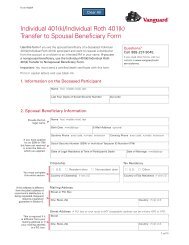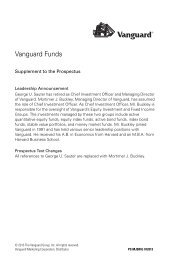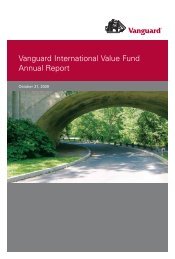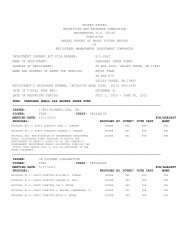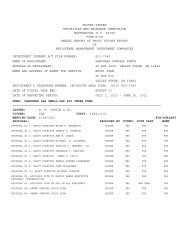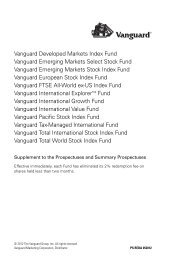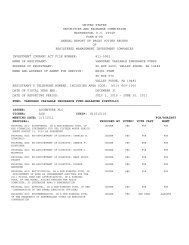Vanguard International Stock Index Funds Annual Report
Vanguard International Stock Index Funds Annual Report
Vanguard International Stock Index Funds Annual Report
Create successful ePaper yourself
Turn your PDF publications into a flip-book with our unique Google optimized e-Paper software.
98<br />
Glossary<br />
Beta. A measure of the magnitude of a fund’s past share-price fluctuations in relation to the ups and<br />
downs of a given market index. The index is assigned a beta of 1.00. Compared with a given index, a<br />
fund with a beta of 1.20 typically would have seen its share price rise or fall by 12% when the index<br />
rose or fell by 10%. For this report, beta is based on returns over the past 36 months for both the<br />
fund and the index. Note that a fund’s beta should be reviewed in conjunction with its R-squared<br />
(see definition). The lower the R-squared, the less correlation there is between the fund and the<br />
index, and the less reliable beta is as an indicator of volatility.<br />
Equity Exposure. A measure that reflects a fund’s investments in stocks and stock futures. Any<br />
holdings in short-term reserves are excluded.<br />
Expense Ratio. The percentage of a fund’s average net assets used to pay its annual administrative<br />
and advisory expenses. These expenses directly reduce returns to investors.<br />
Inception Date. The date on which the assets of a fund (or one of its share classes) are first invested<br />
in accordance with the fund’s investment objective. For funds with a subscription period, the inception<br />
date is the day after that period ends. Investment performance is measured from the inception date.<br />
R-Squared. A measure of how much of a fund’s past returns can be explained by the returns from the<br />
market in general, as measured by a given index. If a fund’s total returns were precisely synchronized<br />
with an index’s returns, its R-squared would be 1.00. If the fund’s returns bore no relationship to the<br />
index’s returns, its R-squared would be 0. For this report, R-squared is based on returns over the past<br />
36 months for both the fund and the index.<br />
Short-Term Reserves. The percentage of a fund invested in highly liquid, short-term securities that<br />
can be readily converted to cash.<br />
Turnover Rate. An indication of the fund’s trading activity. <strong>Funds</strong> with high turnover rates incur<br />
higher transaction costs and may be more likely to distribute capital gains (which may be taxable<br />
to investors). The turnover rate excludes in-kind transactions, which have minimal impact on costs.




